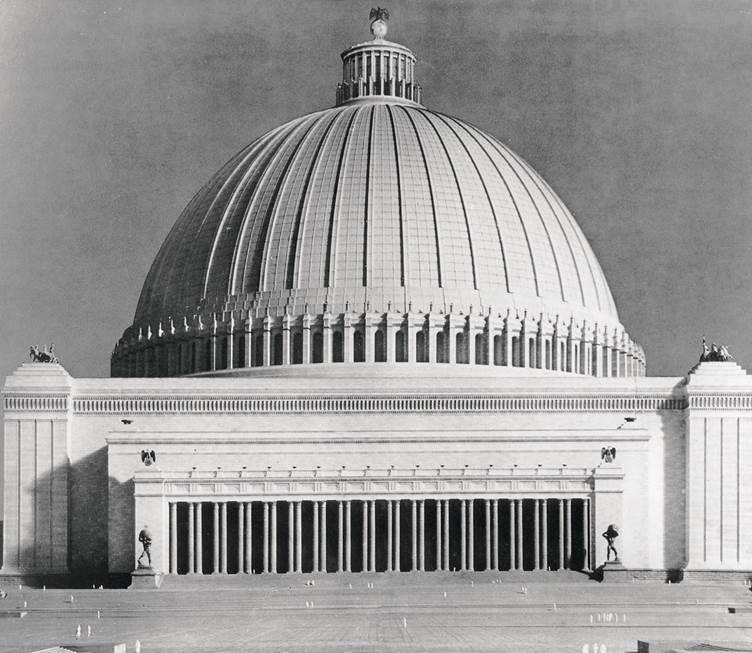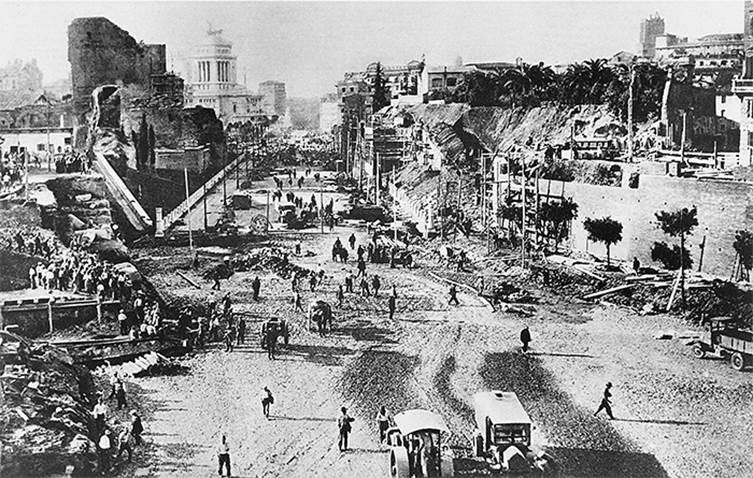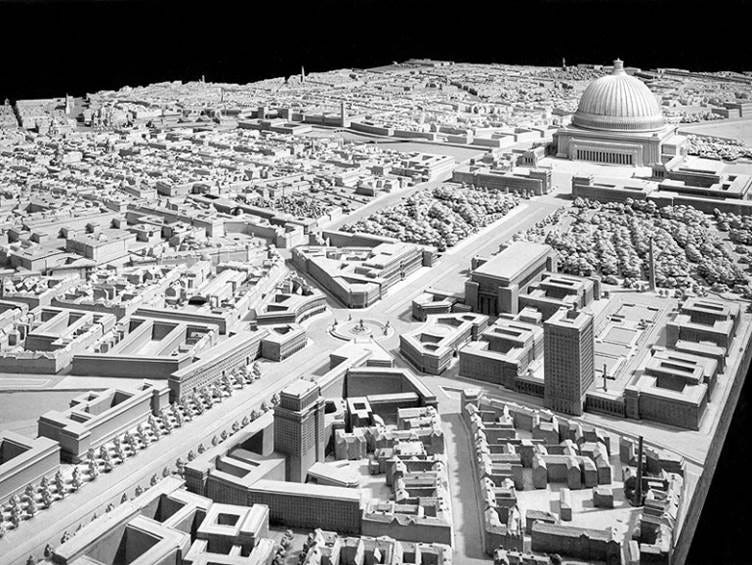The Executive Order You Probably Missed, and What it Means for American Politics
How Trump’s Obsession with Neoclassical Architecture Echoes Imperialists, Dictators, and White Supremacists
Model for Hitler's Volkeshalle, modelled on Hadrian's Pantheon in Rome (image via)
Amid the chaos of Trump’s second term—policy reversals, trade wars, and race-baiting spectacle—one executive order has slipped under the radar. The Executive Order on Promoting Beautiful Federal Civic Architecture might seem trivial next to his headline-grabbing moves, but beneath its dry bureaucratic language lies something far more revealing: a calculated effort to tether the American state to an aesthetic tradition long used by empires, nationalists, and fascists to project power, racial superiority, and imperial destiny.
This isn’t Trump’s first attempt. His original 2020 mandate, overturned by Biden, sought to enforce neoclassical architecture as the default for federal buildings—a preference he has now resurrected. At first glance, it’s an odd move from a man whose brand is built on gold-plated kitsch. But in the broader context of political history, it places him in a lineage of leaders who have weaponized classical aesthetics to craft ideological narratives.
The order claims that “Ancient Greek and Roman public buildings were designed to be sturdy and useful, and also to beautify public spaces and inspire civic pride.” It even invokes a 1309 decree from Siena, which declared that “Whoever rules the City must have the beauty of the City as his foremost preoccupation.” That such lofty rhetoric comes from the man who gave the world Trump Tower is ironic enough. But the bigger problem? The idea that neoclassical architecture uniquely fosters civic pride is, to put it politely, complete bullshit. The strong public feelings expressed of Paris’s postmodern Centre Pompidou, London’s brutalist National Theatre, or Gaudí’s Catalan modernist masterpieces proves that architectural beauty is deeply subjective—and its power to inspire pride, even more so.
But the real tell comes later in the order:
“President George Washington and Secretary of State Thomas Jefferson consciously modeled the most important buildings in Washington, D.C., on the classical architecture of ancient Athens and Rome. They sought to use classical architecture to visually connect our contemporary Republic with the antecedents of democracy in classical antiquity.”
In Public Archaeology and Critical Heritage studies, we have a word for this: teleology – the practice of shaping the past to justify the present. And when it comes to neoclassical architecture, history shows us that this aesthetic has always served more than just artistic preferences – it has been a tool for shaping empire, ideology, and exclusion.
The problem with neoclassical architecture
Neoclassical architecture emerged during the 18th century. Although the baroque and renaissance styles borrowed from Classical aesthetics, they were also heavily influenced by European Christian architecture. Neoclassicism stripped these influences away, leaving a more ‘pure’ recreation of the architecture of Ancient Greece and Rome.
Baroque building (L), with curved lines, ornamentation, and religious status, vs neoclassical building (R), with clean lines and plain facade (image via)
Looking back, the emergence of the neoclassical style during the Enlightenment was not a great surprise. This period was in many ways defined by a deliberate effort in the arts, philosophy, politics, and morality to create and emphasise cultural links between the 18th century European Empires, and those of the Classical world.
This helped to facilitate a wider pivot away from the Christian worldview which had dominated these areas in Europe for centuries, and towards one centred on rationality, individualism, and capitalism. It was further aided by the emergence of Archaeology and Classical Philosophy as scientific disciplines during the period. Where before, European’s understanding of the art, architecture, and philosophies of the Classical world was understood only through the work of church scholars, and often imbued with a Christian agenda, now the rich and powerful were able to interpret Classical sources directly.
And the new modern worldview held several advantages for the rich and powerful of Europe. Where historically, the trade in enslaved people was at odds with traditional Christian morality, the brutal system was now justified through references to Aristotle’s theory of ‘natural slavery’. The intrinsic collectivism of Christian society was also eroded in favour of capitalist individualism, justified through references to Plato’s Republic.
This process also enabled colonialism and imperial exploitation to be justified, with the re-emergence of the idea that Greek and Roman imperialism had a wide benefit for those in their empires. Just as Roman roads were taken as evidence for infrastructure and development in the provinces, the idea that “Britain gave India the railways” came to be seen as proof of the advantages of modern imperialism.
Closer association with the Classical world also had important implications for the identity of the new, individual nations of Western Europe. Where before, Europe’s borders had been a messy, impermanent collection of principalities, fiefdoms, kingdoms, towns, and cities. Now, these disparate groups needed to be brought together into new nation-states, with a collective history – the more glorious, the better. And what more glorious past to celebrate than that of the Greek and Roman Empires?
The idea of a direct line of inheritance from the Greek and Roman world to the European empires of the 18th and 19th centuries was therefore of increasing importance to these dominant nation-states. The widespread use of the neoclassical style for French, Italian, German, and British civic architecture was an easy-to-understand way to illustrate this to their populations, an Enlightenment-era meme signalling a selective origin story, a break from Europe’s fundamentally Christian past, and the natural and noble tradition of imperial conquest and exploitation.
It is this tradition which so inspired American’s Founding Fathers to also adopt the neoclassical style for the civic architecture in their own fledgling nation-state. Benjamin Franklin and Thomas Jefferson had been in Europe during the period that the style was first adopted, and a number of influential European neoclassicists were bought on to design the White House and the US Capitol, which was modelled on the Parthenon in Ancient Rome. The Founding Fathers were not ignorant to what we would consider the darker elements of the neoclassical movement – Thomas Jefferson himself cited Aristotle’s ‘natural slavery’ in his discussion of the trade in enslaved peoples in Notes on the State of Virginia. It would therefore be very difficult to claim that this style was chosen on purely aesthetic grounds – the leaders of America were also invested in establishing the Graeco-Roman pedigree of their own nation-state, as visualised in its civic architecture.
How neoclassical art became fascist architecture
Trump is not the first leader to attempt to legislate a return to the high point of neoclassical architecture. An early example comes from the 1850s, French Emperor Napoleon III ordered the centre of Paris to be essentially ripped up, destroying centuries of living heritage and real French history, in order to build the neoclassical model city we all now know.
By the 20th century, however, a fixation with the neoclassical style became more closely associated with the European fascist movement. It is easy to present fascist as at-odds with the ideals of the Enlightenment. However, in many ways the ideology represents Enlightenment imperialist thought, pushed to its logical extreme. A commitment to rationality, ‘science’ and Classical wisdom facilitated a shift towards cold, genocidal eugenics theories, and later practice. The need to establish credible and glorious national origin myths led to increasingly violent, exclusionary nationalism and eventually chauvinistic white supremacism. The Classical imperative for colonialism became an obligation, to restore the Roman Mediterranean Empire, or to establish Lebensraum for the Germanic people.
The same goes for the veneration of the Greek and Roman tradition, and the need to illustrate this through neoclassical architecture, which became an obsession for fascist governments.
Mussolini centred his entire political ideology on the idea that modern Italians were the direct, pure descendants of the Roman Empire. Much fascist symbolism, from the fasces emblem that they adopted, to the straight-armed salute later used by Hitler (and possibly Elon Musk?), was appropriated from real or imagined Roman traditions. A restoration of the ‘proper’ grand neo/classical architecture of Ancient Rome was a logical continuation of this project. Perhaps inspired by Napoleon III, Mussolini ordered archaeological excavations and architectural restoration in the Italian capital on an unprecedented scale. Centuries of Enlightenment, Renaissance, and Medieval architecture was cleared away, revealing the original Roman architecture. Where this was in ruins (and most of it was), buildings were painstakingly restored. New buildings were ordered in the neoclassical style to compliment these restored ruins. In short, our image of the Eternal City today is in fact the product of one 20th century fascist dictator.
Mussolini's excavations in Rome (image via)
The Nazis too sought to draw on the neoclassical style. Hitler saw the Roman tradition as the high point of human civilisation, a totem of Aryan cultural and biological superiority. Much of the monumental architecture of the Third Reich was neoclassical, including the Berlin Olympic Stadium. Hitler also had plans to rebuild the entirety of Berlin following his victory in WWII as Welthauptstadt Germania, a neoclassical ‘world capital’, centring on the Volkeshalle (see cover image), a 180,000 capacity temple to Hitler and the Nazi ideology, modelled on Hadrian’s Pantheon in Rome.
The Nazi Olympiastadion for the 1936 Olympics (image via)
Model for Welthauptstadt Germania (image via)
These dictators drew on Classical heritage for the same reasons as their imperial predecessors: to emphasise the superiority of their people and ideology, demonstrated through associations with the Classical empires. Once again, neoclassical architecture served as a very useful shorthand for this belief – is this the legacy that Trump is hoping to emulate?
Architecture matters: populism, ideology, and legacy
It must be noted that neoclassical architecture was not adopted by all the fascist leaders in the early 20th century. In Portugal, Salazar sponsored a new school of uniquely Portuguese architecture called Português Suave, with styles and public monuments celebrating Portugal’s ‘Golden Age’ in the era of exploration and early imperialism. Spain’s Franco drew on neoclassical elements in his public architecture, but these were fused with more traditional Spanish styles.
This is also reflected in the civic architecture of current populist regimes. Whilst Trump is the only world leader attempting to mandate neoclassicism, he is not alone in seeking to celebrate a particular architectural style. In India, Modi’s regime has sought to establish and emphasise a largely imagined ‘traditional Hindu’ architecture from the pre-Mughal era. Hungary’s Viktor Orban has also given significant support to efforts to restore the Habsburg architecture of the country, synonymous with the glories of the Austro-Hungarian Empire.
While exceptions, these examples also serve to prove the rule: emphasising a particular architectural and aesthetic style which reflects an imagined ‘golden age’ in a nation’s history is a tactic used to centre the ideology and legacy of populist and fascist governments. Trump, with his agenda of ‘Make America Great Again’, is no stranger to the power of this type of nostalgia in populist politics, as evident in his inaugural address last month.
So, while Executive Order #13967 might seem like an overwhelmingly dull focus for the President’s first 100 days, it offers revealing clues about his political ideology and worldview. Architecture matters. Aesthetic beauty is not objective, and heritage is never neutral. Trump’s fetishization of neoclassicism places him in an unenviable lineage of imperialists, dictators, and white supremacists – figures who have invoked the supposed Classical lineage of the West to justify exploitation, expansionism, and eugenics.
Without speculating on whether Trump harbours fascist ideations, one thing is clear: if he did, this is exactly the kind of legislation he would introduce.








